Lights, camera, action — the making of the Turnbull Library's mini-documentary
A look behind-the-scenes at the making of a new documentary about the Alexander Turnbull Library and its staff and collections — plus a chance to watch the finished film.
Lights, camera, action!
In the interest of preservation, actually, no lights.
Through the generosity of a Lottery grant, secured during lockdown, the Turnbull Endowment Trust commissioned a five-minute mini-documentary to capture a flavour of the Alexander Turnbull Library. This proved to be no mean feat.
Anna Cottrell, maker of the Great War Stories series knows the Turnbull well and has worked with and used the Library for many years. Appointed as Director for the mini-documentary, her mandate, post-COVID lockdown, was to show the depth and breadth of the collections: the variety of formats, and the conservation and curatorial expertise lovingly brought to the care of our documentary heritage.
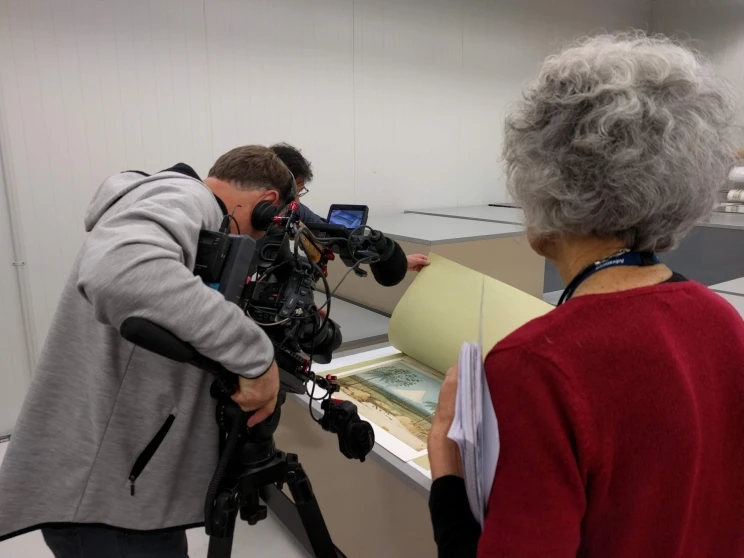
Director Anna Cottrell was tasked with showing the depth and breadth of the Turnbull Library collections.
Assigned to the position of Executive Producer (as I later realised in the credits) I was tasked with co-ordinating venues and talent to optimise a tight filming schedule.
Condensed into two, two-day sessions, filming spanned the labyrinth of the library’s facilities and beyond, and involved engaging with staff, researchers and an external conservator.
Filming in freezing storage conditions
Cameraman Ivars Berzins (wrapped in goose down) brought his artistic eye to navigate the 2 degree Celsius photographic storage vaults and kilometres of books, manuscripts and newspapers. Throughout all of this, we were under the guidance of Vesna Zivkovic, the Turnbull’s Preventive Conservator — ensuring protection of all items during filming.
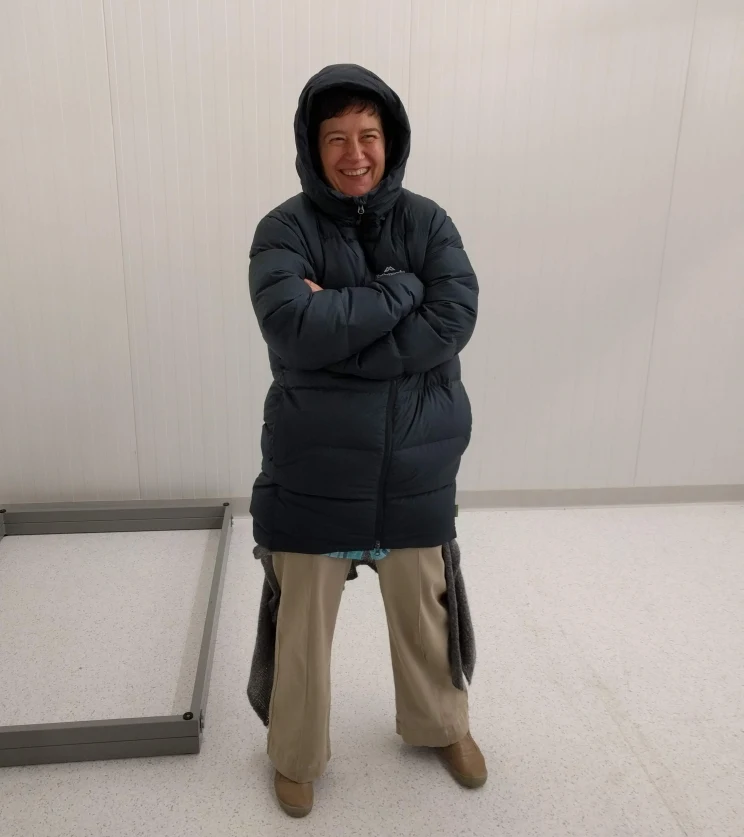
In the photographic store with Vesna Zivkovic, the Turnbull Library’s Preventive Conservator.
Rare books from Antarctica
Rare books containing stunning hand-painted birds, the ‘Beans’ edition of Aurora Australis printed in freezing conditions on Shackleton’s journey to Antarctica, and samples of cloth collected throughout the Pacific on first voyages were filmed.
For me the most moving of all is to hear the story of a security guard reciting Islamic poetry from an eight hundred year-old book, still taught in schools today, and what that meant to him.
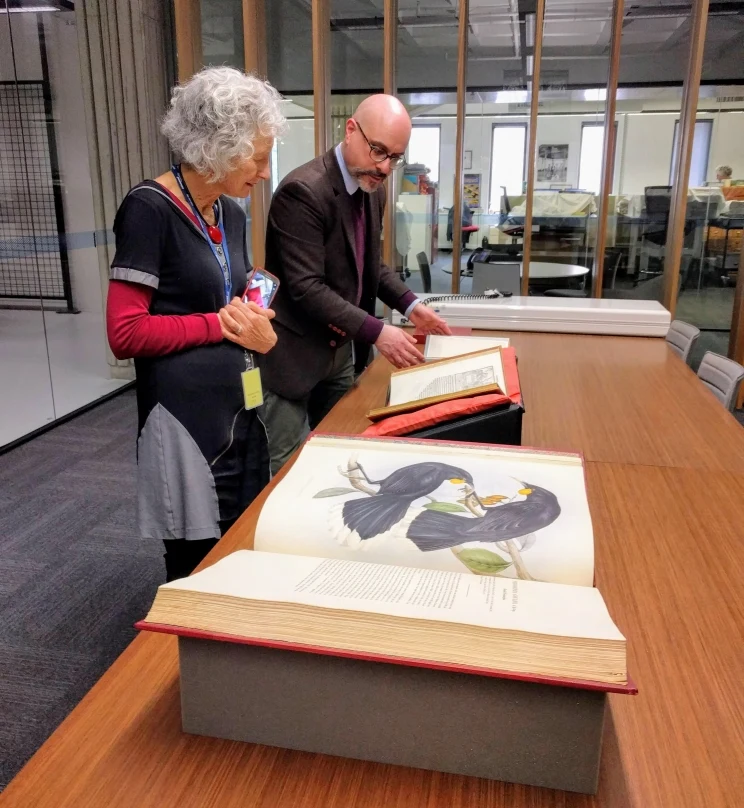
Director Anna Cottrell with Rare Books Curator, Anthony Tedeschi.
Mīharo Wonder
We gained an insight into the Miharo Wonder exhibition with the show’s curatorial team, discussing the intricate details of some individual exhibition pieces. Pieces like the ‘Meek Tree’ revealed innumerable hours of painstaking inkwork by hand, depicting the artist’s view of New Zealand in 1876. And a handmade book created in Featherston by a Japanese prisoner of war, recorded lyrics of Japanese songs on the back of cigarette packets – the only paper available to him.
The Mīharo Wonder exhibition, the second in the Turnbull Library centenary series, opens on 26 February 2021.
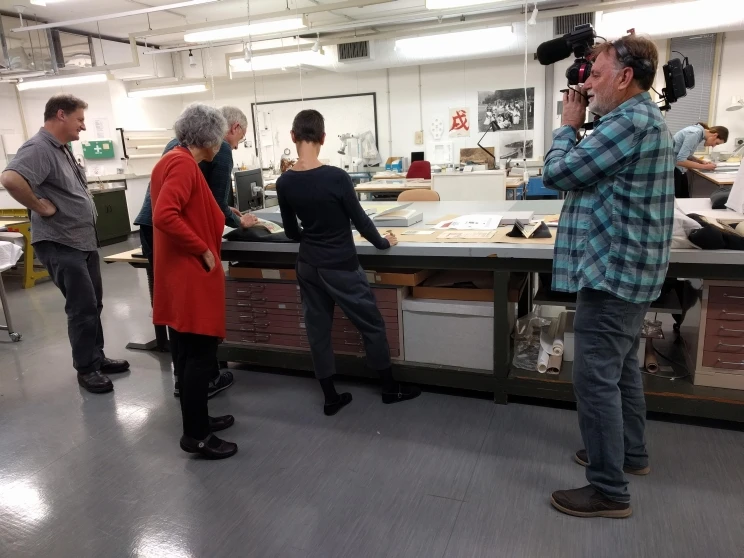
Film crew with the Miharo Wonder curatorial team.
Conservation and cleaning
In the conservation lab the careful removal of silt and dirt from books with scalpel and brush, indicate that items are donated or procured in a variety of conditions.
They are painstakingly cleaned whilst not losing details of their journey to the library. External conservator Carolina Izzo’s delicate hand brushed away the grime of a West Coast past, transforming the painting into the centrepiece of the upcoming exhibition.
With the guidance of Dr Oliver Stead, we explored the array of ephemera, prints, watercolours and oils that the Turnbull holds. Behind each work is a story of adventure, admiration or adversity. Some are by unknown artists and represent people, events and terrain significant to New Zealand’s past. All are fascinating and some clearly in need of treatment before they can be shared with a wider audience.
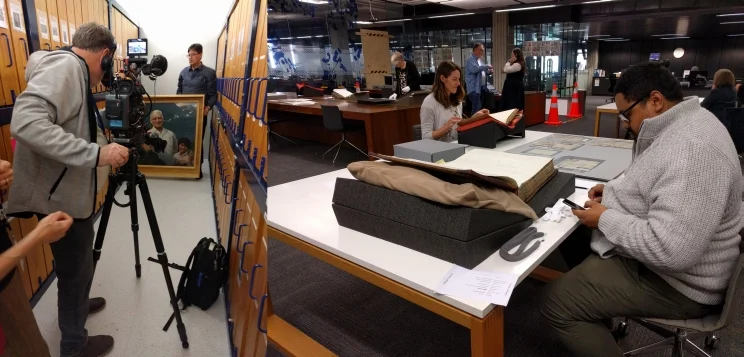
L: In the painting store with curator, Dr Oliver Stead. R: Staff and researchers in the Katherine Mansfield Reading Room.
Digitisation
Digitising these works across so many formats requires technical know-how. The Imaging Services team captures scenes and portraits from glass plate negatives, printing in tiny prayer books, or paintings on enormous canvases. Whatever the item, care is paramount throughout.
The Reading Room remains an essential access point. Historians Jock Phillips and Jane Tolerton shared their time and interests, claiming the Turnbull to be an irreplaceable, wonderful, world-class resource.
Caitlin Lynch’s revisit of a previous film endeavour, told the story of an unsung women’s suffrage champion.
The workings of the music, sound, digital and microform collections were captured, too. Unfortunately, we missed the meticulous work that goes into detailing the metadata that sits behind the arrangement and description of individual items and collections.
Four days of filming simply could not allow us to do justice to every facet of the library.

Cameraman Ivars Berzins with the Scott family.
Donations
Architect John Scott’s archive arrival into the Library provided an opportunity to film the respect and aroha that accompanies donations of work. The Scott family were welcomed and hosted with a ceremony that showed the commitment to care for these works forever.
Now the impossible task of delivering a five-minute film has been completed. But with all the intricate content, the result stretched to sixteen minutes. The combined creative talents of Anna Cottrell, Ivars Berzins and editor Peter Metcalf have culminated in an updated view of the library, overlaid with a stunning music compilation from Ian Leslie.
Small vignettes coming in 2021
Over summer 2020/21 The Turnbull Endowment Trust plan to draw on unused footage to commission several small vignettes, focusing on individual interviews. Watch this space for releases through social media during 2021.
Please follow The Turnbull Endowment Trust on Facebook / Instagram / Linked In.
This may well be my first and last movie-making experience. I am grateful to all who shared their insights, accommodated requests for time (often at the last minute) and who guided us through the treasures that are cared for every day.
Exhausted by the process of filming, I met a donor supporting the Trust, Barbara Blake, and I recall saying to her, ‘I love my job. I am lucky to learn something new every day!’
And so, the legacy of Alexander Turnbull continues. Please join The Turnbull Endowment Trust in supporting the Library at turnbulltrust.org.nz or contact@turnbulltrust.org.nz.
Meri Kirihimete to all.
A mini-documentary made to celebrate a centenary of the Alexander Turnbull Library. Many thanks to the Turnbull Endowment Trust for there support in the making of this documentary.
Embedded content: https://www.youtube.com/watch?v=zOub_I3SP6I&t=312sTranscript — A Century of Wonder — An Alexander Turnbull Library mini-documentary
Visual
Gloved hand taking a cover off a painting.
Audio
Music
Visual
Images of items from the Alexander Turnbull collections including small container, mirror, manuscript printed and handwritten, posters, paintings.
Words appear on screen music, diaries, websites, drawings, recordings
Audio
Man's voice: It's a wonderful thing that the Turnbull Library is 100 years old. Every year, between 300 and 500 individuals, community groups, organizations gift things to the Turnbull Library.
Visual
A man speaking. Words Chris Szekely, Chief Librarian Alexander Turnbull Library appear on screen.
Audio
Chris Szekely We've got a century of trust behind us, a century of gifting a century of researchers who have used their collections and generated new knowledge.
Visual
Dr Jock Phillips, Historian talking. Dr Phillips walking up the stairs to enter the National Library.
Audio
Dr Jock Phillips: Well the ATL has been an absolute treasure house. It's a world-class institution. For a historian, it's absolutely irreplaceable.
Visual
Hands opening a diary. One page has small bundles of hair clippings in it. Audrey Waugh
Audio
Woman's voice: Well today I've brought out Joanna Turnbull's autograph album.
Visual
Woman talking. Words Audrey Waugh, Research Librarian Manuscripts appear on screen.
Audio
Audrey Waugh: So, this is a fantastic collection item in the manuscripts collection.
Visual
Hands opening a diary. Page with writing and a sketch of a woman.
Audio
Audrey Waugh: Joanna Turnbull is Alexander Turnbull's sister, fondly known as Sissy to the family in all of their correspondence.
Visual
Audrey walking into the Katherine Mansfield Reading Room with a collection item in her hand. She walks to a table where a researcher is waiting for the item.
Audio
Audrey Waugh: I love being able to work with researchers on a really wide variety of topics, bringing that sparkle to the reading room. And helping people discover things that are really significant, both historically and personally.
Visual
Woman talking to Audrey.
Audio
Jane Tolerton: But that other photo you brought me, there's this lovely piece where he gives a speech in Christchurch in July 1887, and he writes to his wife to thank her for the note she sent him.
Visual
Researcher pointing to a picture in a book.
Audio
Jane Tolerton: That's Mary Vogel, there she is, there, and later he says I made a rattling good speech.
Audrey: Oh, fantastic.
Visual
Woman talking to Audrey. Words Jane Tolerton, Historian appear on screen.
Audio
Jane Tolerton: I've never seen that quote in any women's suffrage book, so that's new. It's wonderful to have.
Visual
Hands opening a folder with handwritten material in them. Audrey then talks to camera.
Audio
Audrey Waugh: These papers are 130 years old, and yet researchers are still able to find new discoveries and bring new meaning to the collections.
Visual
Woman turning pages of a large photo album full of black and white photos. Words Amalaratna, Research Librarian. Amalartna points to the images as she talks about them.
Audio
Amalaratna: So this is Scott's expedition to the Antarctic, 1910. The Terra Nova British Antarctic Expedition. This is the dog party, the dog camp with the horses. And this is the relief party, here.
Visual
Shot panning across the reading rooms and boxes of material. Words photographers, personal pagers, oral history, exhibitions, albums, lyrics, kete show on screen.
Audio
Music
Visual
Man sitting at desk with two screens. The screens have large images on them. Words Mark Beatty, Imaging Technician show on screen. Full screen image of painting of a house.
Audio
Mark Beatty: This is a painting by Peter McIntyre, and it shows the Turnbull House. So, this is the origins, this is where we all started. Officially became the Turnbull Library in 1920, when it opened to the public.
Visual
Man looking at lots of images on a screen. Then close ups of a Māori family wearing European clothing.
Audio
Mark Beatty: Beautiful image here of the family together useful details on the dresses, what they're wearing. We've digitized the original glass plate negative and processed it from being a negative into a positive.
Visual
Wall with image of Alexander Turnbull hanging and words Alexander Turnbull Library on the wall. Image changes to a painting of Alexander Turnbull. Woman walks past painting to an exhibition cabinet. Words, donations, paintings, seminars, sketches and lectures appear on screen.
Audio
Chris Szekely: Alexander Turnbull was a wealthy young guy. He had two big passions in his life. One was yachting, his other great passion was he was an obsessive collector.
Visual
Man talking to camera.
Audio
Chris Szekely: He was focused on two things mainly, anything to do with New Zealand and the Pacific exploration.
Visual
Woman walks to table with item and sits down. Looks at item. Close up of item. Words Suliana Vea, Research Librarian Pacific appear on screen. Suliana on screen. Image of a performing arts groups.
Audio
Suliana Vea: We have a lot of items here belonging to Māori to Mate Noa and the Pacific as well. And people can just type in a search, and if they find something like I did last night, then, yeah, we want to see it. Made me feel really emotional because it involves my uncle who's no longer alive. He was a part of a performing arts group, and they were performing all over. They went to Germany, they went to England, and he used to always tell us these stories, and sadly, when you're young you don't realize how important those stories are.
Visual
Man walking between storage cases. Pulls out a vertical drawer with a modern painting of a man, and angel. Words Dr Oliver Stead, Curator Drawings, Paintings, Prints appear on screen.
Man shows us the original of Charles Heaphy's Mount Egmont water colour.
Audio
Oliver Stead: Mary McIntyre painted this portrait of Pat Hanley, and what's also quite amazing about it is that there's a very beautifully rendered detail of a painting by Tony Fomison in the lower right-hand corner.
Well,to me personally the Turnbull Library published a series of prints after famous New Zealand watercolors in its collection in the 60s. And I grew up with Charles Heaphy's beautiful watercolor, Mount Egmont from the southward, on my bedroom wall. Many, many years later, to be looking after the real thing is just such a privilege.
Visual
Man walking an looking at music posters on a wall. Words Dr Michael Brown, Curator Music appear on the screen.
Audio
Guitar music
Michael Brown: I think what's really satisfying about the job is that working with labels like Flying Nun, by digitizing that material, it actually allows it to be used again. It allows it to be remastered and reissued, or in some cases issued for the first time.
Visual
Woman putting a floppy disk into a floppy disk drive. Words Flora Feltham, Digital Archivist appear on screen.
Audio
Flora Feltham: So I am a digital archivist here at the Alexander Turnbull Library, and part of my job involves getting files off really old kinds of media. So use an old internal floppy disk drive from my computer to try and image this disk. So part of our job is about having to hook up old technology with modern technology, because, of course, when we're talking digital archives we're talking digital files that were being used up to 30 years ago. You really, really have to fix things often. It's really fun, why doesn't it sound fun?
Visual
Open book with picture of a birds as pages are turned. Man standing in front of four rare books in book holders. Aurora Australis front plate. Words Anthony Tedeschi, Curator Rare Books, Fine Printing appear on screen. Hands show book being opened.
Audio
Anthony Tedeschi: There's never a dull moment, I wouldn't think, being a rare books curator. This is one of the library's copies of the Aurora Australis. So, this is the first book to be printed, illustrated, and bound in Antarctica by Ernest Shackleton and members of his crew. I showed the binding first because this is made from recycled packing crates. We think they printed about 100 copies, and I'm pretty sure this is the etching press.
Visual
Shot of storage. Man sits at desk. Pulls a box out of a bigger box. Opens the box to show a recording on tape. Hands winding the tape onto a machine. Words Phil Brownlee, AV Conservation Technician show on screen. Instruments showing audio levels. Man talking to camera.
Audio
Woman's voice: We present the Alex Lindsay String Orchestra, conducted by Dobbs Franks, leader Ruth Pearl.
Phil Brownlee: Old recordings of New Zealand music are probably the, where my interests lies. It's one of the interesting things about this work is that we don't know exactly what's on the tape until we put it on the machine. The huge variety of the content that I deal with, people telling their stories, and old music recordings, primary historical sources. These tapes were recorded 60 years ago, and the sound on them is as clear as the day it was recorded.
This work was written by Bartók in 1935 at the request of--
We've also got the radio presentation, which is of historical-- historically interesting in itself. The voices of the old YC announcers.
Visual
Woman walking in front of banner outside the National Library advertising He Tohu exhibition. Woman in the library looking at a table full of papers. Looking over the woman's shoulder at the papers. Words Caitlin Lynch, Researcher and Filmmaker appear of screen.
Audio
Caitlin Lynch: I did a history degree and so I loved coming here to find out more about what I was researching. You always discover something unexpected.
Visual
Black and white photo of six men and two women. Woman speaking to camera. Woman looking at suffrage statue. Woman sitting at desk looking at papers. Woman looking at paper headed ‘The Sweating System’. Paper has image of a woman sewing, a sick man in bed and children sitting around her in distress. Shots of cartoons. Footage from ‘Harriet Morison’ short film showing a woman walking.
Caitlin Lynch: I was researching this woman named Harriet Morrison, who was involved in the suffrage movement but she isn't mentioned nearly as much as someone like Kate Sheppard. So I came to the ATL where I could look through all these newspapers and manuscript files. And I could draw out all these amazing cartoons of Harriet Morrison from the newspapers. And then we compiled all that information into a little documentary about Harriet Morrison which went on to be nominated for the Bert Roth History Awards and the Bert Roth files we actually used in the project. These were the files that had all this information about her. And so it was a really cool way to engage with the archives.
Visual
Woman walking towards glass sculpture of Kate Sheppard. Woman talking to camera. Words Suzanne Snively, Deputy Chair, Turnbull Endowment Trust appear on screen.
Audio
Suzanne Snively: I love this sculpture. I'm a trustee on the Alexander Turnbull Library Endowment Trust, which is a foundation that's been set up in order to make sure that the collection at the Alexander Turnbull Library is available to all New Zealanders. Not only did Kate Sheppard campaign for a woman's right to vote but for universal suffrage.
Visual
Shot of the reading rooms.
Audio
Music
Visual
Man pulling paintings out of storage.
Audio
Orchestral music.
Visual
Hands pulling a record out of its cover. Close up of vinyl record being played. Close up of record cover, Country Girl Maria Dallas. Woman shows record. Words Bronwyn Officer, Senior Conservator Sounds show on screen.
Audio
Our means of preservation is to digitize the analog object for all time.
Singing ‘Tumbling, a tumbling a tumbling down...’
This is a lacquer disk. You can see crazing on this record. Physically, I'm not going to do anything to it. But by playing the content, we preserve it into the future. This has been requested by the great-granddaughter of the bagpipe player.
Bagpipe music.
Visual
Woman wearing lab coat and white gloves sitting in front of a microscope and preparing things. Woman looks through microscope at an painting of adults and children with parcels on a bridge. Words Carolina Izzo, Director, Studio Carolina Izzo. Hands doing conservation work on the painting. Woman looking through microscope. Gently brushing of painting with a soft brush. Woman writes notes about work doing on painting.
Audio
Carolina Izzo: My name is Carolina Izzo, and I have a studio in New Zealand called Studio Carolina Izzo. It's a unique unique works that has the label in paper, fragment of a label paper work attach it to the surface. So this painting is painted over a cardboard. It's a poor material, and doesn't seems has a priming underneath, but still searching it out.
Through the microscope I was able to see that it was varnished recently, I don't think it was a regional varnish. Because for example where there were fragment of paper, and where the paper was missing. there was no varnish. So you know that that was something I'm exploring that possibility there was the level was actually attached at the time that painting was completed.
I noticed that the environment where the painting was done had some kind of a dust problem, because there's a lots of pigment used that has embedded. Very beautiful looking under the microscope.
Visual
Woman wearing gloves opening a cardboard box and taking a book out. Words Sarah Askey, Conservator appear on screen. Hands holding book open. Gloved hands point at parts of the book cover. Woman sitting at desk. She puts a mask on. Woman scrapping book with tool and brush. .
Audio
Sarah Askey: So this is a box of books that were donated last year. The descendants of a man called Charles Calvert, so this is his private library collection. But they've been quite badly damaged by silt. This is actually a book in Māori, 1848. I'm going to be chipping these accretions of silt off using a scalpel and then working through the pages with a very soft brush and a smoke sponge.
I quite like the problem solving. When you have things come to you in they're sort of not usable as books anymore, figuring out how to make them meet present day kind of needs for access and use but still retaining what it is about their history which is important to what they are.
Visual
Gloved hands working with film. Words appear on screen Theresa Kele, Librarian Microfilms.
Theresa Kele: We're looking at 35 millimeter mass of microfilm of the Tāupo Times from 1953 to 1954. This is an old acetate film, and I'm going through it to replace poor splices, and replacing them with archival splices. And this will help to keep-- preserve the microfilm for longer.
Visual
Man sitting at desk looking at handwritten letters. Photo of a couple.
Audio
Man’s voice: My dearest. My own darling.
Jock Phillips: Beautiful. I've got the letters that were written by Peter Howden to his wife, which he wrote every day of his war service from the end of 1915 until he died in 1917. So it's a great love story.
Visual
Sign !Caution! Work in progress. Words on screen Mīharo Exhibition, Peter Ireland, Gallery, Exhibitions Specialist: Dr Fiona Oliver, Curator NZ and Pacific Publications. People looking at items on a table. A document with a photo and Chinese characters and an official stamp on it.
Audio
Peter Ireland: Effectively a passport which allowed Robin Hyde, the New Zealand writer, to travel in China in the 1930s.
Fiona Oliver: Robin Hyde was a pen name, and her real name was Iris Wilkinson.
Visual
A gloved hand holding a small card with a blue and white painting on it. The card is turned over to show of small handwriting. Man talking words Peter Ireland, Gallery, Exhibitions Specialist appear on screen.
Audio
Peter Ireland: It's a handmade postcard by the New Zealand artist Frances Hodgkins. Essentially, a thank you card to thank somebody for having her to stay when she was in France, so probably from the 1930s and 1940s. One of the reasons we liked it so much was that it's quite a rare instance, of the work in our collection.
Visual
Woman using tool to open pages of a book. Pages of the book with drawings of people in Pacific Islands. Turning pages of the book to show more drawings of Pacific Islands.
Audio
Peter Ireland: We don't know who the artist is, but we know the association of it with a particular voyage.
Visual
Three people taking a material cover off a very large piece of paper. Man and woman looking at a sheet with drawings, maps and lots of words. Words Margaret Morris, Senior Conservator, Works in Paper appear on screen.
Audio
Chris Szekely: Look at that.
Margaret Morris: He's trying to encapsulate the history of New Zealand in one great big sheet.
Chris Szekely: Well the history of New Zealand from European--
Margaret Morris: His point of view, yes.
Chris Szekely: First sight, if you like.
Margaret Morris: It's from his point of view, that's right.
Chris Szekely: Yes.
Margaret Morris: I just love this item. I love the fact that all of this is done by hand.
Chris Szekely: All by hand.
Margaret Morris: It's remarkable.
Visual
Two women standing together. People standing together, children and adults. Words John Scott’s architectural works — donation appear on screen. People carrying items into the Library.
Audio
Powerful chanting by two Māori women's calling to each other in welcome during a karanga.
Chris Szekely: E te whānau au Hone Scott. Tēnā koutou i o manaakitanga me te aroha, nō reira, nau mai, haere mai ki to tātou whare. Tena koutou, tena koutou. Kia ora tātou katoa.
Visual
Drawers opening full of photographs. Man looking through photographs. Pulls a picture of two cloaked Māori women. Photo of pohutukawa and caravan, paper with photo and Chinese script, small ceramic box, drawing of indigenous people sitting around a fire, poster, record. Words Chris Szekely, Chief Librarian appear on screen.
Audio
Chris Szekely: I absolutely believe that every New Zealander has a right to expect that the documentary record of their family, their community, their culture, their country is kept, cared for, and made available when they want it or when their descendants want it. That's what this is all about.
Visual
The Turnbull Endowment Trust thanks all who participated. Alexander Turnbull Library staff and whānau. National Library of New Zealand Te Puna Mātauranga o Aotearoa, Studio Carolina Izzo.
This film was made with support from a Lottery Environment and Heritage Committee Grant. Special thanks to Women's Refuge for permission to film the Kate Sheppard sculpture. All other items featured are held in the Alexander Turnbull Library collection.
Music
Douglas Lilburn — collection, Xiing Wang, Jian Liu, Flying Nun, Maria Dallas, Jonathan Besser, Ana Kenny and choir, Afokoula Singers ‘Atenisi Institute, Tonga.
Editor — Peter Metcalf
Sound mix — Ian Leslie
Camera — Ivars Berzins
Director — Anna Cottrell AC Productions
Special thanks to all Alexander Turnbull Library staff who appeared in this film.
John Sullivan, Leader Curatorial Services
Jenni Chrisstoffels, Research Librarian Pictorial
Cecilia Ng, Research Librarian
Rita Havel, Research Librarian
Ulu Afaese, Librarian
Samuel Ardell, Librarian
Lynette Shum, Oral History Advisor
Brendan O’Brien, Conservation Coordinator Exhibitions
Keith McEwing, Assistant Curator Music
Laura van Echten, Conservation Technician
Greg Weiss, Conservation Technician
Cellia Joe-Olsen,. Heritage Advice Coordinator Outreach Services
Dale Cousens, Team Leader Collection Development
Producer — Anna Cottrell
Executive Producer — Paula MacLachlan, Turnbull Endowment Trust
Logos, Turnbull Endowment Trust, ATL100 Alexander Turnbull Library National Library of New Zealand Te Puna Mātauranga o Aotearoa. Lotto, Funded by NZ Lottery Grants Board.
Audio
Piano music.
Any errors with the transcript, let us know and we'll fix them email digital-services@dia.govt.nz.
This was so fantastic to see! Such amazing work you are all doing to preserve our history and make it accessible. Well done!